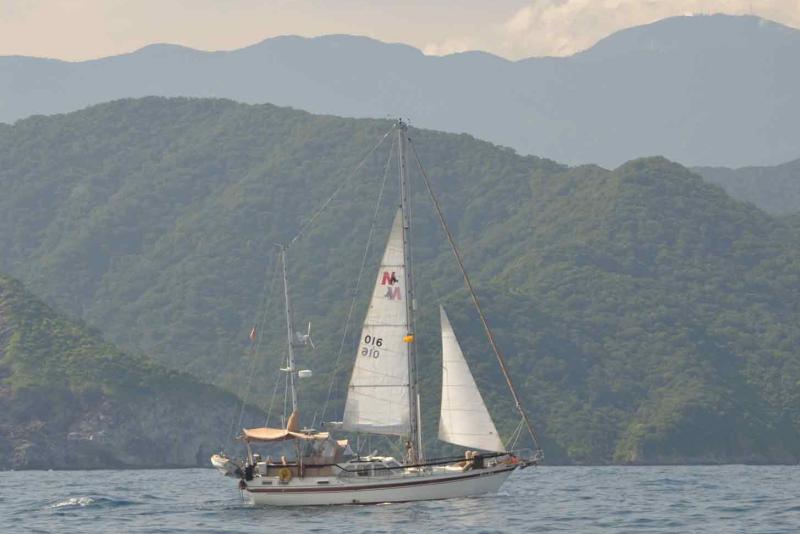| Denali Rose Ships Log - 10 November 2011 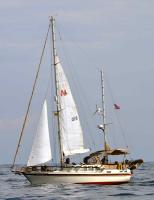 Jack
and I flew into Curacao on September 10th, with four large duffle bags, two backpacks
and two computer bags filled with boat parts and one change of clothes for each
of us. Our boat, Denali Rose, had been stored on dry land for the hurricane season
at Curacao Marine, the island's working boat repair yard. Because of boat insurance
requirements, we could not launch until the 19th of the month. In the interim,
we booked an efficiency apartment in a nice residential area a short distance
from the boatyard. Our rental car was a tiny Chinese four-door called a Great
Wall, but the letters had fallen off the trunk, so it now it reads "GreatW,"
and the glove box was held closed with a shoestring, but the engine and the AC
worked. Jack
and I flew into Curacao on September 10th, with four large duffle bags, two backpacks
and two computer bags filled with boat parts and one change of clothes for each
of us. Our boat, Denali Rose, had been stored on dry land for the hurricane season
at Curacao Marine, the island's working boat repair yard. Because of boat insurance
requirements, we could not launch until the 19th of the month. In the interim,
we booked an efficiency apartment in a nice residential area a short distance
from the boatyard. Our rental car was a tiny Chinese four-door called a Great
Wall, but the letters had fallen off the trunk, so it now it reads "GreatW,"
and the glove box was held closed with a shoestring, but the engine and the AC
worked.
Although Curacao is in the same time zone
as the Eastern Daylight Time so we had no jet lag, but we did need to adjust to
the tropical heat and humidity. One day at lunchtime, I (Fred) climbed into the
car and the inside temperature read 104º.
Jack spent the days in
the boat yard, I stayed in our apartment updating inventories. Each sailing season
we bring down all of our medications and vitamins for the entire stay. We also
inventoried and replenished our canned goods, enough to last at least until we
arrive in Panama in February. We took our list of meats to the largest grocery
store and the butcher packed and flash froze each set of meats as we requested
and omitted the bulky Styrofoam. The only snag was that, Curacao being a Dutch
island, the cuts of meat were labeled in Dutch! However, everyone knows a veleesburger
is a hamburger patty? Jack finished painting the
boat's hull, replaced the sacrificial zincs and we launched on schedule. About
that time, he discovered that the diesel engine's stop solenoid had given up the
ghost. Luckily, he found a new one that almost fit but required a new bracket
to be custom made. Yes, there were replacements, identical to the old one, in
the USA at half the cost BEFORE shipping and import duties. However, we had a
proverbial "bird in the hand," with the Dutch one. In addition, with
the local one, we would not be held hostage to the shipping gods; plus if we waited
for the US solenoid to be mailed, it might bounce around for weeks through island
customs offices and gather dust on island time. We simply could not chance it.
If we wanted to be ready to head west when the forecast was right, we could not
delay our departure. So, we bought the Dutch one, made a new bracket, welded the
metric thread to the USA thread connector, Jack installed it and we were off to
Aruba. On the way there, 10 dolphins romped and played beside our boat's bow as
if to say, "Happy Birthday, Jack!" Hello
Aruba! There is nothing as gratifying as arriving at a familiar place and finding
the same friendly people there to greet you. I just wish every Caribbean island
had a marina as well run as the Renaissance Marina in Aruba! While there, we also
had dinner with our friend, Janine, and her very nice friend, Gerome. We also
met fellow boaters, Michele and his wife, Pamela and their three children from
Toronto, Canada, aboard a sailing ketch called Viatrix. They were also sailing
to Colombia, so we had a buddy boat heading west with us.
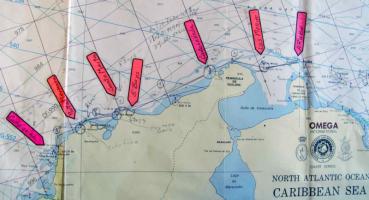 Jack
talked with weather expert, Chris Parker, each morning and they agreed that we
should leave Aruba for Colombia, Wednesday, October 5th. This was a shakedown
cruise for our AIS (Automatic Identification System) that shows us where commercial
shipping vessels are, their ship's name, current heading and location, and it
shows them where we are. As we were passing a commercial freighter, it looked
like it was sitting still. Suddenly, it started moving and crossed right in front
of us, at less than a half a mile. Our AIS set off its alarm, Jack radioed to
the ship and the man at its helm calmly said, "Yes we see you, please pass
behind us." Jack proudly told me this incident had paid for the AIS! Jack
talked with weather expert, Chris Parker, each morning and they agreed that we
should leave Aruba for Colombia, Wednesday, October 5th. This was a shakedown
cruise for our AIS (Automatic Identification System) that shows us where commercial
shipping vessels are, their ship's name, current heading and location, and it
shows them where we are. As we were passing a commercial freighter, it looked
like it was sitting still. Suddenly, it started moving and crossed right in front
of us, at less than a half a mile. Our AIS set off its alarm, Jack radioed to
the ship and the man at its helm calmly said, "Yes we see you, please pass
behind us." Jack proudly told me this incident had paid for the AIS!
This would be our first overnight sail in three years. Jack took the first
night watch when we sailed just north of a Venezuelan island. It had a navigation
warning light on the island but was surrounded by rocks that spread out for miles
around it. Luckily, the rocks showed up on our radar and we had plenty of clearance.
Sailors just cannot trust the charts to be perfectly accurate with the GPS due
to different chart reference systems. I took over at midnight and stayed up until
almost dawn. Our prayers for calm seas were answered. We sailed on until 11 a.m.
when we reached the beautiful Colombian anchorage of Cabo de la Vela, about 120
miles southwest of Aruba. The next day we planned to sleep in and have a late
start, but at 10 a.m., we were surprised to find someone hailing us from a weathered
wooden fishing boat. The fisherman had been paid to bring a travel writer and
photographer out to our boat to interview us and take photos! The Colombian writer
and his Italian photographer stayed for an hour. Jack gave them the names and
email addresses of the boaters who had shared their sailing notes about the Colombia
coast with us. That way, if the Colombian publishes his travel book, our friends'
guidance might be included
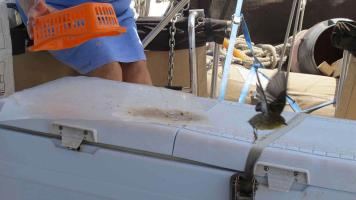 We
pulled up our anchor and set sail though the night for the charming city of Santa
Marta. As usual, I had the dark of night watch with huge storm clouds and periodic
flashes of lightning but no rain. At about 3 a.m., I was climbing down the companionway
steps when something small bumped my left shoulder and fluttered ahead of me down
to the salon table. It was a tiny bird, about 3 inches long; the poor little thing
obviously had been blown out to sea by the strong winds of the thunderstorm. I
put a small basket over the bird, offered it some cracker crumbs and water but
it was not interested in anything but freedom. When Jack awoke to take the wheel,
I told him about our feathery stowaway that was under the basket. In the late
morning, when we sailed closer to shore, we released our little passenger who
immediately took off for land. We
pulled up our anchor and set sail though the night for the charming city of Santa
Marta. As usual, I had the dark of night watch with huge storm clouds and periodic
flashes of lightning but no rain. At about 3 a.m., I was climbing down the companionway
steps when something small bumped my left shoulder and fluttered ahead of me down
to the salon table. It was a tiny bird, about 3 inches long; the poor little thing
obviously had been blown out to sea by the strong winds of the thunderstorm. I
put a small basket over the bird, offered it some cracker crumbs and water but
it was not interested in anything but freedom. When Jack awoke to take the wheel,
I told him about our feathery stowaway that was under the basket. In the late
morning, when we sailed closer to shore, we released our little passenger who
immediately took off for land.
Along the way at about noon, a pod of
about 20 dolphins of all sizes entertained us for at least 10 minutes. Jack videotaped
them as they leaped up in unison! This dolphin experience was one we will never
forget!
Next stop was Santa Marta's brand new marina, within easy walking
distance to the center of the 500-year-old town. We had hired an excellent agent,
Dino, to handle our check-in with the Colombian Customs and Immigration offices.
We met up with our Canadian "buddy boat" family and toured the plantation
where Simon Bolivar (the South American equivalent to George Washington) had spent
his
final months of life.
Jack checked the weather forecast again
with Chris Parker and we decided to leave Santa Marta at noon on Thursday, October
13th, and anchor near the town of Rododero. Unfortunately, the winds clocked around
causing our boat to roll constantly at anchor, affording us little rest that evening.
We pulled up the anchor at 3:00 a.m. on October 14th, during a thunderstorm and
sheets of rain and occasional lightning. To add a bit more entertainment to the
situation, a tug pulling a huge dredge came out of the fog and soup and crossed
our bow about 300 feet to spare. (Needless to say, its AIS was not turned on,
so we received no warning.) We did not need coffee to stay awake after an experience
like that! Why were we leaving in the dark of night?
You might ask. The answer is that we needed to arrive during daylight hours when
we reached the mouth of a huge river farther ahead of us, called the Rio Magdalena.
This river drains 1/4 of the country of Colombia into the Caribbean Sea. During
the rainy season, entire trees and other debris (very unfriendly to sailboats)
float out the mouth, which is two miles wide. Sure enough, when we arrived at
the river, we watched the blue/green Caribbean waters turn a cocoa brown and carried
small islands of water hyacinths and small logs across our path.
Late that afternoon we arrived at our final anchorage, Punta Hermosa, where we
dropped the anchor behind a natural jetty, in protected waters. Cool and gentle
breezes lulled us to sleep shortly after sunset. It was a good thing, since we
needed to raise the anchor at dawn to reach our final destination, Cartagena,
and the Club de Pesca Marina, before dark. Neptune
decided that our quota of fair winds had expired and it was payback time. The
changed direction and came at us from the nose. To explain this, picture yourself
riding, sidesaddle, on a 43-foot rocking horse, on a lumpy carpet; then, continue
galloping along for six hours. That was our final hours before turning into protected
harbor at Cartagena. Little did we know that we were arriving on the Saturday
afternoon of a three-day holiday weekend. The marina staff was waiting to grab
our lines (in Spanish the lines are "sogas"). We were tired and sore,
but we were very happy to finally arrive. Jack had started researching this trek
three years ago; all his hard work paid off. To celebrate, we popped the cork
on the Prosecco bubbly we had brought from Curacao.
From the stern of our boat, we have free entertainment here each weekend. We can
looks over to the fuel dock frequented by local babe magnet powerboats and macho
fishing boats. According to Jack, watching the big power boat captains jockeying
to get fill their tanks is a great show, free of commercials!
That first afternoon, after connecting to shore power (110-volts) and to the water
line, we walked down the dock looking for dinner. That is when we learned that
the marina was deserted and closed. Since it was a three-day weekend for something,
they just closed up with only security and thank goodness, the bartender! This
marina had one of the top restaurants but it was closed for the holiday! He told
us about another restaurant nearby but it was dark and we were new to town. He
could see we were reluctant to venture out the gate. He said, wait a moment, please.
He went back to the cook, who was preparing dinner for the employees and they
took pity on us. Within minutes, he served us fresh sea bass filets, French fries,
and a salad! The tab came to $50 including a few drinks, but worth every peso.
What a wonderful welcome to Cartagena! Thanks to
the many international cruisers here in the harbor, we have found a local Spanish
teacher who comes to our boat twice a week to teach us the language. Already we
feel at ease hailing a cab to tour museums and the shopping mall, etc. Each weekday,
the boaters use the marine radio to broadcast an informal "cruisers' net,"
covering current local weather, security and medical incident reports, help for
fellow cruisers and upcoming events. I volunteered to run the Friday morning broadcast
and Jack reports the weather, which he pulls down from the internet.
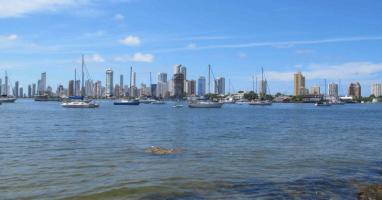 Cartagena
has a population of over 1 million people and thanks to our boating friends here,
we have also found a local carpenter and brass refinisher to help us renovate
the boat. Yes, our boat, Denali Rose, is on the market for sale, and while we
have received some initial nibbles, we are taking our boat broker's advice: only
work on projects that you will enjoy yourselves. Part of the enjoyment of working
on these "nice to have" boat projects is meeting the artisans and speaking
with them in Spanish. We never leave the boat without a dictionary, a map and
a cell phone. We never know how long it will take to find the correct place, but
we know that once we have found it, we will be richer in experience from the adventure. Cartagena
has a population of over 1 million people and thanks to our boating friends here,
we have also found a local carpenter and brass refinisher to help us renovate
the boat. Yes, our boat, Denali Rose, is on the market for sale, and while we
have received some initial nibbles, we are taking our boat broker's advice: only
work on projects that you will enjoy yourselves. Part of the enjoyment of working
on these "nice to have" boat projects is meeting the artisans and speaking
with them in Spanish. We never leave the boat without a dictionary, a map and
a cell phone. We never know how long it will take to find the correct place, but
we know that once we have found it, we will be richer in experience from the adventure.
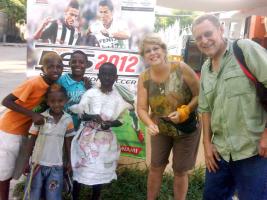 Yesterday,
as part of Cartagena's 200th liberation festivities, kids dress as devils (similar
to our Trick-or-Treat) and we had been advised to carry small change (100 pesos
= $.05 cents US) to give to them. Sure enough, we met some 6-year-old boys who
acted ferocious dragging a classmate dressed as a devil, but were thrilled to
find that two Norte Americanos (North Americans) knew about the tradition and
forked over the coins! Yesterday,
as part of Cartagena's 200th liberation festivities, kids dress as devils (similar
to our Trick-or-Treat) and we had been advised to carry small change (100 pesos
= $.05 cents US) to give to them. Sure enough, we met some 6-year-old boys who
acted ferocious dragging a classmate dressed as a devil, but were thrilled to
find that two Norte Americanos (North Americans) knew about the tradition and
forked over the coins! We look forward to the Miss
Colombia beauty contest here next week, Thanksgiving celebrated with fellow cruisers
and the Christmas holidays in the "land where palm trees sway." In January
we head to the remote San Blas islands in Panama. Here
is the website Jack created to sell our boat: https://sites.google.com/site/nauticat43forsalesvdenalirose/ 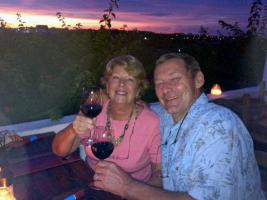
Cheers
from Cartagena!
Susan "Fred" and Jack Webb
Aboard
the sailing vessel Denali Rose |
